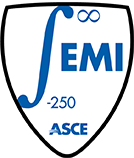
Carleton Professor Emeritus Frank Louis DiMaggio, 94, died peacefully on January 4, 2024. He was born in New York City on September 2, 1929, to Serafino and Maria (Barbuto) DiMaggio. He was married to Irene (Koehn) DiMaggio and had two sons, Sam and Peter. After graduating from Stuyvesant High School in 1946, he attended Columbia University, where he received a BS in 1950, MS in 1951, and his PhD in 1954 from the Department of Civil Engineering and Engineering Mechanics. His PhD advisor was Prof. Hans Bleich.
Dr. DiMaggio was drafted into the United States Army in 1954, where he served as a Structural Analyst in the Armed Forces Special Weapons Project at the Pentagon in Washington, DC. After serving in the U.S. Army from 1954-56, he came back to Columbia University as an Assistant Professor in the Department of Civil Engineering and Engineering Mechanics and remained an active member of that department until his retirement in 1998, promoted to Associate Professor in 1960, Full Professor in 1964, and Robert A.W. and Christine Carleton Professor in 1978. He also served as Department Chair from 1974-78.
Professor DiMaggio embodied all the human and scientific qualities of a great professor: an inspiring teacher, a brilliant scientist, a loyal colleague and friend. He conducted seminal research in the general area of fluid-structure interaction. He developed a substructuring method for the transient response of submerged shells with complex internal structures without having to determine the structural stiffness matrix. This method has been used to estimate the response of submarines subjected to underwater explosions. Together with Ivan Sandler and Margareta Rehak, he established an analytical procedure to determine the dynamic response of floating structures subjected to underwater explosions, including the effects of bulk cavitation. This method has been used in the analysis of surface ships. He also utilized acoustic approximations in fluid-structure interaction problems to uncouple the equation of motion of the fluid from that of the structure on the surface of a submerged shell and to create absorbent (non-reflecting) boundaries in the far fluid field. These methods have been used in acoustic problems involving submarine noise and in the structural response of submarines to underwater explosions.
In collaboration with Ivan Sandler, Professor DiMaggio has developed the so-called CAP models for the inelastic constitutive behavior of soils under dynamic loading. These models have proven to be extremely versatile in describing the nonlinear, inelastic behavior of soils under very general loading conditions. An important advantage of these models is in the fact that their mathematical structure is such that spurious lack of uniqueness or instabilities do not develop during their implementation in numerical codes. The influence of Professor DiMaggio’s pioneering ideas along these lines remains major in modern geotechnical literature.
He also served as a consultant for the engineering firm Weidlinger Associates from 1956 to 1998. Professor DiMaggio was a registered Professional Engineer in the State of New York and a Fellow of the American Society of Civil Engineers (ASCE). He served as a member of the Executive Committee of the ASCE Engineering Mechanics Division from 1980-1988, becoming its Chairman in 1985-1986. He was awarded a Senior Postdoctoral Fellowship by NSF in 1962, the Mel Baron Medal by the Shock and Vibration Information and Analysis Center in 2006, and the Raymond D. Mindlin Medal from the Engineering Mechanics Institute of ASCE in 2010.
Professor DiMaggio’s reputation as a teacher was legendary among both undergraduate and graduate students at Columbia. He taught established courses in his field and introduced new ones and his lectures were an example of clarity and rigor. While a very accomplished researcher, he would say that his doctoral students were his greatest achievement as an engineering scholar and his mentoring of PhD students went well beyond the technical aspect. His teaching excellence was recognized by Columbia’s Society of Older Graduates by awarding him the Great Teacher Award in 1970.
As a colleague, Prof. DiMaggio was loyal, generous, supportive but never wavered from his core principles and values. He was always approachable and willing to offer his advice based on his vast experience. Professor DiMaggio spent his later years mentoring young engineering professors at Columbia. His sharp thinking and straightforward advice with unique wisdom and vision inspired the next generation and shaped the culture among his research community and workplace. He has been a role model for many of his young colleagues. As an authority of engineering mechanics with high academic achievements, he was open to learning, discussing and solving problems with junior faculty.


